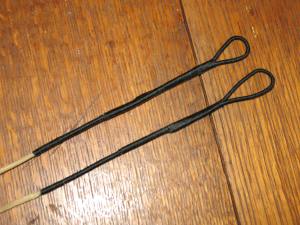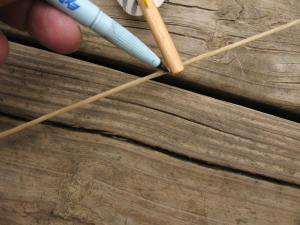How to Make Continuous Loop for Bowstring
So now that we have our string jig and our serving dispenser together, we can make a bowstring. You can use many different things for the actual string. You can buy some B-50 Dacron that is specifically made for bowstrings, but I prefer to use the waxed Dacron that is sometimes referred to as artificial sinew. It's easy to find at craft stores and relatively inexpensive. It also has the advantage of already being waxed. If you use B-50 you will also need beeswax to rub on the string.
Before we start wrapping our string onto the jig I want to give you a little diagram of what we are doing. Since my string jig is over five feet long it makes it hard to show it all in a photo. I thought a diagram might help.

Now let's get started. My two starter dowels are glued permanently in place. I'm going to make a 60 inch bowstring, so I set my two movable dowels with the tall one at 60 and the short one at 62.

To start the wrapping I tie the end of my Dacron string below the cross pin of the permanent short dowel and then I bring the string over the cross pin on the permanent tall dowel. You can start on either side of the tall dowel.

Now I run the string down and loop it around the tall movable dowel. You should be on the same side of this dowel as you were on the permanent dowel. You don't want your string criss-crossing in the middle.

Keep a little tension on the string and run it back to the permanent tall dowel and around. You continue this until you have as many strands as you want in your bowstring. If you want to make a bowstring with a total of six strands you will continue looping the string until you have five strands on the side that is tied to an end post and four strands on the side that is not tied to an end post. The reason for this will become clear in a moment.

When you tie the end of your string off at the finish, it must be tied to the opposite end from where you started.

You now have two runs of Dacron that are separated by about a ½ inch of space. It is time to apply the serving to what will become the loops of our bowstring.

Measure to the center of the bowstring. Since we are making a 60 inch string, the center will be 30 inches. Mark the center and the measure out four inches to each side of center and make a mark. We are going to apply serving to each of these eight inch sections of bowstring.

To make it easier to work on each strand, place your string spreaders in between the strands to hold them apart.

Being right-handed I always serve from right to left, so that's how the pictures show the process. I start at the mark on the right side of the closest strand and loop my serving around it. I leave an inch or two of tail on the serving and wrap my loops over the top of it. It is important to lay your serving loops right next to each other and to keep the serving tight.


Your serving dispenser should be adjusted so that a firm pull will feed more serving out, but if you let the dispenser hang, it will not let serving come out on its own.

When you have covered up about ¾ inch of the tail, you can snip the remainder off. The wrappings will not let the tail come loose.

Keep wrapping the serving around and around until you are about ¾ inch from the far left mark.

At this point you want to take a scrap of Dacron about two feet long. Fold it into a loop and hold it along the bowstring as shown.

Now continue your wrapping, only now you are also wrapping on top of the loop.

Keep wrapping until you go about a ¼ inch past your mark; and then you can stop, reel out about six inches of serving and snip the serving off with scissors. Be sure and keep tension on the serving so that it doesn't un-spool when you cut it.

Now take the end of the serving and stick it through your loop of Dacron.

Pull on the loose ends of the loop, and the end of your serving will be pulled back under the wraps. Snip any excess off, and the wraps will hold the, now hidden, end in place. You have to pull pretty hard on the loop ends, and it will probably compress the loops of serving back up the string. This is why you go about ¼ inch past your mark before ending the serving.


So now you have one section of serving done. Turn your jig around so that you are working from right to left again and do the same thing to the other strand.

Now it's time to cut the ties loose from the short dowels with a pair of scissors.

When you have snipped the string loose, lift it up so that it exposed all the way back to the serving. Now take your scissors and cut off the string right at the edge of the serving. Be careful not to cut the serving or any other strings. Do the same thing to the other tied off string.

Now you can slip the bowstring around on the dowels so that the served area is around the dowels on each end. Off-set the ends of the serving about an inch or so as shown in the photo.

Now we can form the loops. All that you have to do to make the loops is squeeze the two strands together and apply a layer of serving over them as show below.

Run the serving down about six inches and finish it off just like you did before. Voila, you have a loop.

Now do the same thing to the other end. I usually make one small loop to stay in place on the bow, and one larger loop that will slide down onto the limb when I unstring the bow.

It is customary to apply serving to the string in the area where the arrow is nocked. This helps to prevent wear on the string. To locate where to put this serving, just string the bow, nock an arrow, and make a mark on the bowstring.


Apply serving to this area using the same method. I usually make my serving about four inches long with the nocking point in the center of the serving.

If you made your string a little too long, or if it stretches out, all you have to do is twist the string a little to shorten it. I always make my string a little long because it is easy to make it shorter; not so easy to make it longer. In fact, if it is too short you are going to have to start from the beginning and make a longer string.
Source: https://sensiblesurvival.org/2015/06/29/make-a-continuous-loop-bowstring-part-3/
0 Response to "How to Make Continuous Loop for Bowstring"
Post a Comment